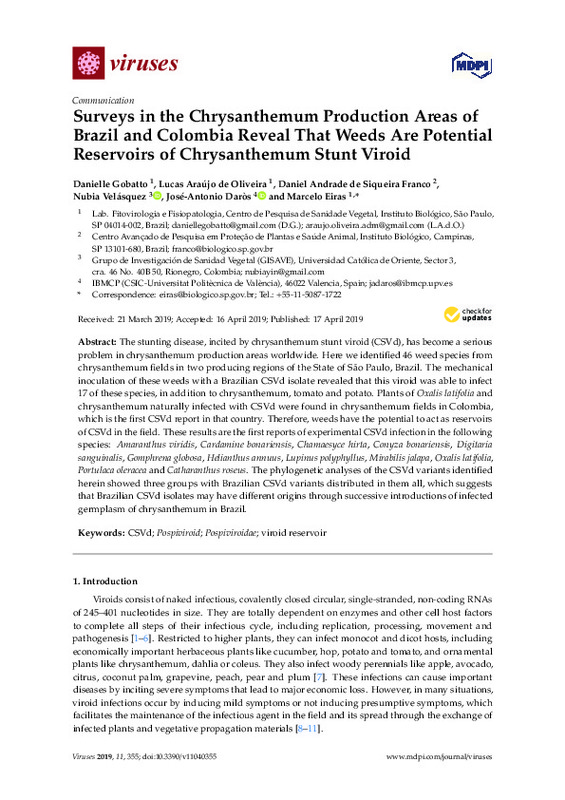Flores, R., Serra, P., Minoia, S., Di Serio, F., & Navarro, B. (2012). Viroids: From Genotype to Phenotype Just Relying on RNA Sequence and Structural Motifs. Frontiers in Microbiology, 3. doi:10.3389/fmicb.2012.00217
Flores, R., Gago-Zachert, S., Serra, P., Sanjuán, R., & Elena, S. F. (2014). Viroids: Survivors from the RNA World? Annual Review of Microbiology, 68(1), 395-414. doi:10.1146/annurev-micro-091313-103416
Flores, R., Owens, R. A., & Taylor, J. (2016). Pathogenesis by subviral agents: viroids and hepatitis delta virus. Current Opinion in Virology, 17, 87-94. doi:10.1016/j.coviro.2016.01.022
[+]
Flores, R., Serra, P., Minoia, S., Di Serio, F., & Navarro, B. (2012). Viroids: From Genotype to Phenotype Just Relying on RNA Sequence and Structural Motifs. Frontiers in Microbiology, 3. doi:10.3389/fmicb.2012.00217
Flores, R., Gago-Zachert, S., Serra, P., Sanjuán, R., & Elena, S. F. (2014). Viroids: Survivors from the RNA World? Annual Review of Microbiology, 68(1), 395-414. doi:10.1146/annurev-micro-091313-103416
Flores, R., Owens, R. A., & Taylor, J. (2016). Pathogenesis by subviral agents: viroids and hepatitis delta virus. Current Opinion in Virology, 17, 87-94. doi:10.1016/j.coviro.2016.01.022
Di Serio, F., Flores, R., Verhoeven, J. T. J., Li, S.-F., Pallás, V., Randles, J. W., … Owens, R. A. (2014). Current status of viroid taxonomy. Archives of Virology, 159(12), 3467-3478. doi:10.1007/s00705-014-2200-6
Diener, T. O., & Raymer, W. B. (1967). Potato Spindle Tuber Virus: A Plant Virus with Properties of a Free Nucleic Acid. Science, 158(3799), 378-381. doi:10.1126/science.158.3799.378
Diener, T. O. (1971). Potato spindle tuber «virus». Virology, 45(2), 411-428. doi:10.1016/0042-6822(71)90342-4
Diener, T. O. (1971). Potato spindle tuber virus: A plant virus with properties of a free nucleic acid. Virology, 43(1), 75-89. doi:10.1016/0042-6822(71)90226-1
HOLLINGS, M., & STONE, O. M. (1973). Some properties of chrysanthemum stunt, a virus with the characteristics of an uncoated ribonucleic acid. Annals of Applied Biology, 74(3), 333-348. doi:10.1111/j.1744-7348.1973.tb07754.x
Palukaitis, P., & Symons, R. H. (1980). Purification and Characterization of the Circular and Linear Forms of Chrysanthemum Stunt Viroid. Journal of General Virology, 46(2), 477-489. doi:10.1099/0022-1317-46-2-477
Haseloff, J., & Symons, R. H. (1981). Chrysanthemum stunt viroid: primary sequence and secondary structure. Nucleic Acids Research, 9(12), 2741-2752. doi:10.1093/nar/9.12.2741
GROSS, H. J., KRUPP, G., DOMDEY, H., RABA, M., JANK, P., LOSSOW, C., … RAMM, K. (1982). Nucleotide Sequence and Secondary Structure of Citrus Exocortis and Chrysanthemum Stunt Viroid. European Journal of Biochemistry, 121(2), 249-257. doi:10.1111/j.1432-1033.1982.tb05779.x
Cho, W., Jo, Y., Jo, K.-M., & Kim, K.-H. (2013). A Current Overview of Two Viroids That Infect Chrysanthemums: Chrysanthemum stunt viroid and Chrysanthemum chlorotic mottle viroid. Viruses, 5(4), 1099-1113. doi:10.3390/v5041099
Agribusiness intelligence/informa (IEG, FNP, Agrianual 2016)http://www.informafnpstore.com.br/agrianual-2016-pr-181-349650.htm
Flores e plantas ornamentais do Brasil (SEBRAE), v.1, Série Estudos Mercadológicoshttp://www.bibliotecas.sebrae.com.br/chronus/ARQUIVOS_CHRONUS/bds/bds.nsf/7ed114f4eace9ea970dadf63bc8baa29/$File/5518.pdf
Horst, R. K. (1977). Effects of Chrysanthemum Stunt, Chlorotic Mottle, Aspermy and Mosaic on Flowering and Rooting of Chrysanthemums. Phytopathology, 77(1), 9. doi:10.1094/phyto-67-9
Yoon, J.-Y., & Palukaitis, P. (2012). Sequence comparisons of global chrysanthemum stunt viroid variants: multiple polymorphic positions scattered through the viroid genome. Virus Genes, 46(1), 97-104. doi:10.1007/s11262-012-0811-0
Flores, R. (2011). VIROIDS IN ORNAMENTALS. Acta Horticulturae, (901), 23-34. doi:10.17660/actahortic.2011.901.2
Matsushita, Y., Tsukiboshi, T., Ito, Y., & Chikuo, Y. (2007). Nucleotide Sequences and Distribution of Chrysanthemum Stunt Viroid in Japan. Journal of the Japanese Society for Horticultural Science, 76(4), 333-337. doi:10.2503/jjshs.76.333
Nakashima, A., Hosokawa, M., Maeda, S., & Yazawa, S. (2007). Natural infection of Chrysanthemum stunt viroid in dahlia plants. Journal of General Plant Pathology, 73(3), 225-227. doi:10.1007/s10327-007-0007-y
Verhoeven, J. T. J., Arts, M. S. J., Owens, R. A., & Roenhorst, J. W. (1998). European Journal of Plant Pathology, 104(4), 383-386. doi:10.1023/a:1008688023649
Runia, W. T., & Peters, D. (1980). The response of plant species used in agriculture and horticulture to viroid infections. Netherlands Journal of Plant Pathology, 86(3), 135-146. doi:10.1007/bf01989706
Ogawa, T., Toguri, T., Kudoh, H., Okamura, M., Momma, T., Yoshioka, M., … Sano, T. (2005). Double-stranded RNA-specific Ribonuclease Confers Tolerance against Chrysanthemum Stunt Viroid and Tomato Spotted Wilt Virus in Transgenic Chrysanthemum Plants. Breeding Science, 55(1), 49-55. doi:10.1270/jsbbs.55.49
Nabeshima, T., Matsushita, Y., & Hosokawa, M. (2018). Chrysanthemum Stunt Viroid Resistance in Chrysanthemum. Viruses, 10(12), 719. doi:10.3390/v10120719
Iraklis, B., Kanda, H., Nabeshima, T., Onda, M., Ota, N., Koeda, S., & Hosokawa, M. (2016). Digestion of chrysanthemum stunt viroid by leaf extracts of Capsicum chinense indicates strong RNA-digesting activity. Plant Cell Reports, 35(8), 1617-1628. doi:10.1007/s00299-016-1977-z
Salzman, R. A., Fujita, T., Zhu-Salzman, K., Hasegawa, P. M., & Bressan, R. A. (1999). Plant Molecular Biology Reporter, 17(1), 11-17. doi:10.1023/a:1007520314478
Codoñer, F. M., Darós, J.-A., Solé, R. V., & Elena, S. F. (2006). The Fittest versus the Flattest: Experimental Confirmation of the Quasispecies Effect with Subviral Pathogens. PLoS Pathogens, 2(12), e136. doi:10.1371/journal.ppat.0020136
Sanger, F., Nicklen, S., & Coulson, A. R. (1977). DNA sequencing with chain-terminating inhibitors. Proceedings of the National Academy of Sciences, 74(12), 5463-5467. doi:10.1073/pnas.74.12.5463
Zuker, M. (1989). On finding all suboptimal foldings of an RNA molecule. Science, 244(4900), 48-52. doi:10.1126/science.2468181
Mackie, A. E., Rodoni, B. C., Barbetti, M. J., McKirdy, S. J., & Jones, R. A. C. (2016). Potato spindle tuber viroid: alternative host reservoirs and strain found in a remote subtropical irrigation area. European Journal of Plant Pathology, 145(2), 433-446. doi:10.1007/s10658-016-0857-2
Choi, H., Jo, Y., Yoon, J.-Y., Choi, S.-K., & Cho, W. K. (2017). Sequence variability ofChrysanthemum stunt viroidin different chrysanthemum cultivars. PeerJ, 5, e2933. doi:10.7717/peerj.2933
[-]









